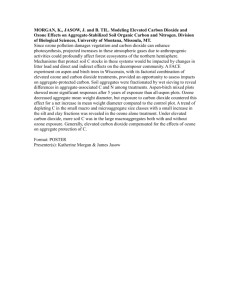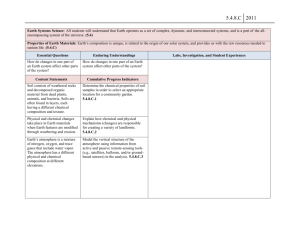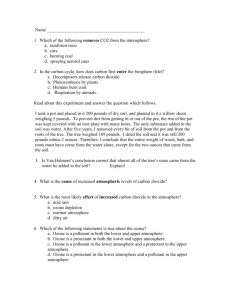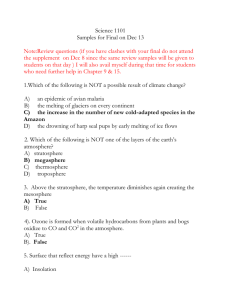env ch 11-15 review (1)
advertisement
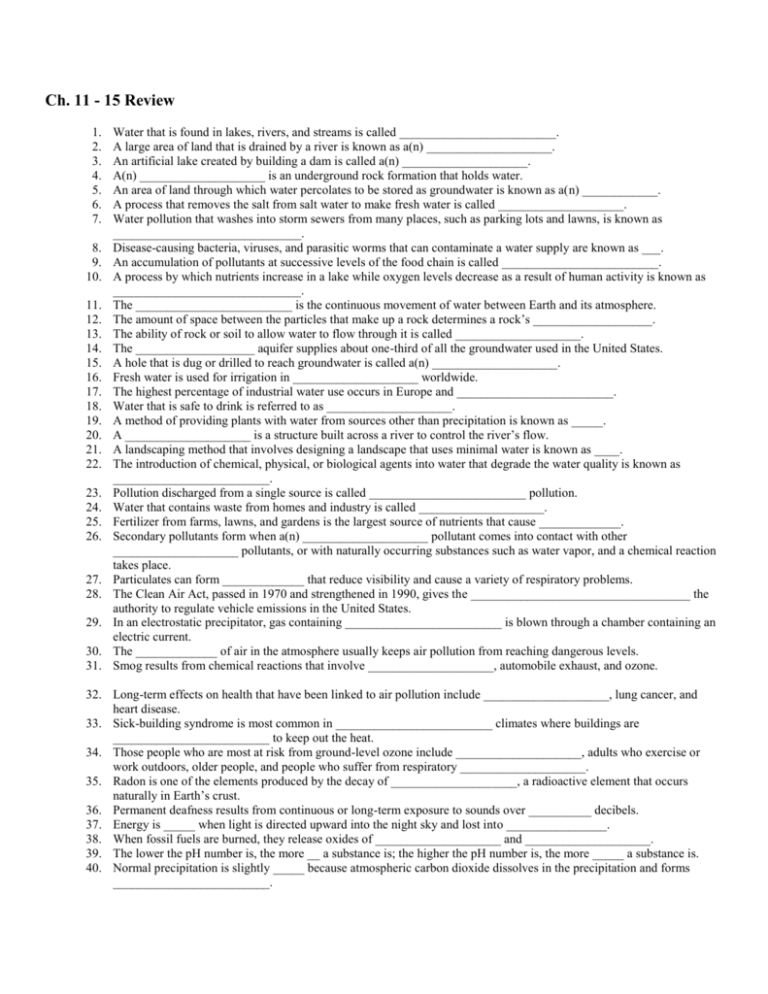
Ch. 11 - 15 Review 1. 2. 3. 4. 5. 6. 7. 8. 9. 10. 11. 12. 13. 14. 15. 16. 17. 18. 19. 20. 21. 22. 23. 24. 25. 26. 27. 28. 29. 30. 31. Water that is found in lakes, rivers, and streams is called _________________________. A large area of land that is drained by a river is known as a(n) ____________________. An artificial lake created by building a dam is called a(n) ____________________. A(n) ____________________ is an underground rock formation that holds water. An area of land through which water percolates to be stored as groundwater is known as a(n) ____________. A process that removes the salt from salt water to make fresh water is called ____________________. Water pollution that washes into storm sewers from many places, such as parking lots and lawns, is known as ______________________________. Disease-causing bacteria, viruses, and parasitic worms that can contaminate a water supply are known as ___. An accumulation of pollutants at successive levels of the food chain is called _________________________. A process by which nutrients increase in a lake while oxygen levels decrease as a result of human activity is known as ______________________________. The _________________________ is the continuous movement of water between Earth and its atmosphere. The amount of space between the particles that make up a rock determines a rock’s ___________________. The ability of rock or soil to allow water to flow through it is called ____________________. The ___________________ aquifer supplies about one-third of all the groundwater used in the United States. A hole that is dug or drilled to reach groundwater is called a(n) ____________________. Fresh water is used for irrigation in ____________________ worldwide. The highest percentage of industrial water use occurs in Europe and _________________________. Water that is safe to drink is referred to as ____________________. A method of providing plants with water from sources other than precipitation is known as _____. A ____________________ is a structure built across a river to control the river’s flow. A landscaping method that involves designing a landscape that uses minimal water is known as ____. The introduction of chemical, physical, or biological agents into water that degrade the water quality is known as _________________________. Pollution discharged from a single source is called _________________________ pollution. Water that contains waste from homes and industry is called ____________________. Fertilizer from farms, lawns, and gardens is the largest source of nutrients that cause _____________. Secondary pollutants form when a(n) ____________________ pollutant comes into contact with other ____________________ pollutants, or with naturally occurring substances such as water vapor, and a chemical reaction takes place. Particulates can form _____________ that reduce visibility and cause a variety of respiratory problems. The Clean Air Act, passed in 1970 and strengthened in 1990, gives the ___________________________________ the authority to regulate vehicle emissions in the United States. In an electrostatic precipitator, gas containing _________________________ is blown through a chamber containing an electric current. The _____________ of air in the atmosphere usually keeps air pollution from reaching dangerous levels. Smog results from chemical reactions that involve ____________________, automobile exhaust, and ozone. 32. Long-term effects on health that have been linked to air pollution include ____________________, lung cancer, and heart disease. 33. Sick-building syndrome is most common in _________________________ climates where buildings are _________________________ to keep out the heat. 34. Those people who are most at risk from ground-level ozone include ____________________, adults who exercise or work outdoors, older people, and people who suffer from respiratory ____________________. 35. Radon is one of the elements produced by the decay of ____________________, a radioactive element that occurs naturally in Earth’s crust. 36. Permanent deafness results from continuous or long-term exposure to sounds over __________ decibels. 37. Energy is _____ when light is directed upward into the night sky and lost into ________________. 38. When fossil fuels are burned, they release oxides of ____________________ and ____________________. 39. The lower the pH number is, the more __ a substance is; the higher the pH number is, the more _____ a substance is. 40. Normal precipitation is slightly _____ because atmospheric carbon dioxide dissolves in the precipitation and forms _________________________. 41. Sulfur dioxide in water vapor ____________________ the openings on the surfaces of plants. 42. Aquatic animals are adapted to live in an environment within a particular ____________________ range. 43. Decreases in numbers of fish caused by the acidification of lakes and streams can influence the livelihood of ____________________ fisherman and people involved in ____________________ fishing. 44. Because acid precipitation falls ____________________, the problem of solving acid precipitation has been difficult, especially at the international level. 45. Almost half of the acid precipitation that falls in southeastern Canada results from pollution produced in ___. 46. Catalytic converters, which are required in ____________________, remove pollutants from exhaust gases before the gases exit through the ____________________. 47. A scrubber is a machine that moves ____________ through a spray of _______ that removes many pollutants. 48. Ventilation, or mixing outdoor _______ with indoor ____, is necessary for good air ____________________. 49. Some indoor air pollutants include _________________________ from dry-cleaning fluid, paradichlorobenzene from air fresheners, and methylene chloride from paint strippers. 50. During a(an) ____________________ period, winds push warm water eastward in the Pacific Ocean. 51. Stratospheric ____________________ is destroyed by chlorine atoms released from CFCs. 52. Trade winds, westerlies, and polar easterlies are examples of ____________________ winds. 53. Damage to ____________________ in cells of living organisms is caused by exposure to UV radiation. 54. The _________________________ is an international agreement that limits CFC production. 55. An effect of El Niño is _________________________ in the southern part of the United States. 56. The statement “It’s hot and sunny today—the temperature is 88ºF at 11 a.m.” describes __________. 57. The development of an ozone hole over the poles is a result of human activities and begins when molecular _______ from chlorofluorocarbons is released into the atmosphere and collects on polar stratospheric clouds. 58. Though CFC production has been cut back, the threat to stratospheric ozone continues because CFCs ____________________ in the atmosphere for decades. 59. The _________ is a process by which the atmosphere traps heat that is radiated from Earth’s surface. 60. A predicted increase in Earth’s average temperature caused by human activities and the subsequent release of gases such as carbon dioxide is known as _________________________. 61. A continuous record from Mauna Loa, Hawaii, reveals that annual average atmospheric CO2 concentrations have ____________________ since 1958. 62. If polar ice masses melt as a result of global warming, sea levels will ____________________. 63. A(n) _________________________ is often found on the inland side of a mountain range. 64. Powerful computers are required to perform the calculations for scientists to develop climatic _________. 65. The statement “Cool summers, cold winters with lots of snow—about 75 cm of precipitation each year” describes ____________________. 66. Water vapor and carbon dioxide help trap heat in the atmosphere near the surface of Earth, so they are called 67. The ________ is an international agreement that seeks to limit CO2 emissions from developed countries. 68. Populations of tiny, shrimp-like animals known as ________________ may be reduced by global warming. 69. As a result of the destruction of stratospheric ozone, scientists believe that ____________________, including frogs, toads, and salamanders, will be especially vulnerable to increased UV radiation. 70. As a result of the destruction of stratospheric ozone, single-celled organisms called _________________________, that live near the ocean’s surface, can be killed by increased UV radiation. 71. Strong circulating winds over Antarctica, known as the _________________________, play a role in the formation of the polar stratospheric clouds. 72. Large quantities of gaseous sulfur dioxide can reach the upper atmosphere following a(n) _______. 73. Sulfur dioxide in the upper atmosphere can lead to the formation of ____________________ that can reduce the amount of sunlight reaching the surface of Earth. 74. One serious consequence of global warming, a rise in sea levels, could result in ________ of beaches. 75. Land that is used to graze livestock is known as ____________________. 76. Before 1850, most people lived in ____________________ areas. 77. The movement of people from rural areas to cities is called ____________________. 78. Many people move to cities in search of ____________________. 79. A land-use planner might use a tool known as __________________ to determine where to locate a new mall. 80. Most damage to rangeland comes from ____________________. 81. Fire stations, roads, and bridges are examples of ____________________. 82. In a(n) _________________________, humans and wildlife live side by side. 83. Areas that are protected from development and environmental damage are known as _______ areas. 84. Moderation of temperature, infiltration of rainwater runoff, and aesthetic value can be provided to urban areas by ____________________. 85. Buses and trains are examples of ______________________________. 86. One of the most important ecosystem services provided by forests is removing _____ from the atmosphere. 87. In clear-cutting, ____________________ trees are removed from an area. 88. In selective cutting, ______________________________ trees are removed from an area. 89. The environmentally preferred method of harvesting trees is _________________________. 90. Land that is poorly suited for building is considered ____________________ land. 91. The first national park in the United States was ____________________. 92. As opposed to urban land, ____________________ land contains relatively few people. 93. In the United States, each person uses the ecosystem services provided by more than ____________________ hectares of land and water. 94. 95. 96. 97. 98. 99. 100. 101. 102. 103. 104. 105. 106. 107. 108. 109. 110. 111. 112. 113. 114. 115. 116. 117. 118. 119. 120. 121. 122. 123. 124. Cities generate and trap ____________________, causing increased temperatures. The opposite of deforestation is _________________________. The negative consequences of harvesting trees using the clear-cutting method are __ and wildlife habitat destruction. Deforestation is particularly harmful in tropical rain forests because the soil is ____________________. In the United States, all citizens share ownership of _________________________. The most protected public lands are ____________________ areas. The amount of a crop produced per hectare (or acre) is called the ____________________. A modern method of controlling pests on crops that seeks to reduce but not eliminate pest populations is called ____. The health problem caused by not eating enough necessary nutrients is known as ____________________. The name for a widespread food shortage that results in many people not having enough food is called a(n) _. The upper layer of soil consisting of rock particles, water, air, and organic matter is the ________________. The loss of fertile soil when it is blown away by wind or washed away by water is called _____________. Land on which crops can be grown is called ____________________ land. Crop production that is limited to meeting one family’s needs is known as ____________________ farming. The diets of people in developed countries tend to be higher in _ than diets of people in developing countries. More energy, water, and land are needed to produce a gram of __ than to produce a gram of food from plants. A(n) ____________________ is a prolonged period during which no rain falls in a particular region. Increases in crop yields during the green revolution resulted in part from the development of new crop _____. Soil that can support the growth of healthy plants is called ____________________. Agriculture that is ____________________ would likely depend on mules for plowing, fertilizer such as manure, and irrigation through ditches. Soil-retaining terraces and contour plowing are both examples of _________________________. The technology of _________________________ allows desirable traits in crop plants to be transferred through the direct manipulation of genes for those traits. No-fishing zones are created as an effort to reduce the effects of _________________________. The raising of aquatic organisms for human use and consumption is called ____________________. Cattle, goats, pigs, sheep, and chickens are all types of ____________________. Animal species bred and managed for human use are referred to as ____________________. The accumulation of salts in the soil, which can be caused by irrigation and low rainfall, is called _________. In farming, a(n) ____________________ is any organism that occurs where it is not wanted, or in large enough numbers to cause economic damage. A(n) ____________________ pesticide is one that does not break down quickly or easily in the environment. The most common form of aquaculture, the _______________, consists of many different individual ponds. Goats, sheep, cattle and other _____________ are cud-chewing mammals with multi-chambered stomachs. Ch. 11 - 15 Review Answer Section COMPLETION 1. 2. 3. 4. 5. 6. 7. 8. 9. 10. 11. 12. 13. 14. 15. 16. 17. 18. 19. 20. 21. 22. 23. 24. 25. 26. 27. 28. 29. 30. 31. 32. 33. 34. 35. 36. 37. 38. 39. 40. surface water watershed reservoir aquifer recharge zone desalination nonpoint-source pollution pathogens biomagnification artificial eutrophication water cycle porosity permeability Ogallala well agriculture North America potable irrigation dam xeriscaping water pollution point-source wastewater artificial eutrophication primary, primary clouds Environmental Protection Agency EPA dust particles circulation sunlight emphysema warm, tightly sealed children, disease uranium 120 wasted, space sulfur, nitrogen acidic, basic acidic, carbonic acid 41. 42. 43. 44. 45. 46. 47. 48. 49. 50. 51. 52. 53. 54. 55. 56. 57. 58. 59. 60. 61. 62. 63. 64. 65. 66. 67. 68. 69. 70. 71. 72. 73. 74. 75. 76. 77. 78. 79. 80. 81. 82. 83. 84. clogs pH commercial, sport downwind the United States automobiles, tailpipe gases, water air, air, quality tetrachloroethylene El Niño ozone prevailing DNA Montreal Protocol increased rainfall weather chlorine remain persist greenhouse effect global warming increased rise desert rain shadow models climate greenhouse gases Kyoto Protocol zooplankton amphibians phytoplankton polar vortex volcanic eruption haze erosion rangeland rural urbanization jobs geographic information system GIS overgrazing infrastructure biosphere reserve wilderness greenbelts 85. 86. 87. 88. 89. 90. 91. 92. 93. 94. 95. 96. 97. 98. 99. 100. 101. 102. 103. 104. 105. 106. 107. 108. 109. 110. 111. 112. 113. 114. 115. 116. 117. 118. 119. 120. 121. 122. 123. 124. open spaces green spaces mass transit systems infrastructure carbon dioxide all medium-sized and mature selective cutting marginal Yellowstone rural 12 heat reforestation soil erosion thin public lands wilderness yield integrated pest management malnutrition famine topsoil erosion arable subsistence proteins and fats meat drought varieties fertile soil traditional soil conservation genetic engineering overharvesting aquaculture livestock domesticated salinization pest persistent fish farm ruminants




